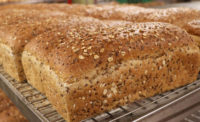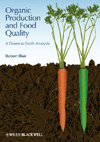Fresh bread—whether sold via the bread aisle, in-store bakery or via foodservice—is the largest category in the baking industry. But even though it still represents a $9.1 billion category at retail, sales have remained relatively flat for the past few years. As such, bakers have been working to find strategies to grow the category.
In order to gain some fresh perspective on this vital aspect of the industry—as well as some perspectives on pizza crusts—we reached out to David DelGhingaro, president, Brolite Products, Inc., Bartlett, IL, for some insight.
Douglas J. Peckenpaugh: What do you see as the biggest trends in retail breads today?
David DelGhingaro: The biggest thing is variety. The prevailing trend is to attract and maintain customers by offering new and unique products and flavors. The bread aisle used to be filled with different white sliced pan bread products. Now, alongside the white pan bread, the aisles are stocked with all sorts of different breads filled with varieties of grains and seeds, sourdoughs, ryes and unique flavor profiles, and new alternative flours. Bakeries constantly innovate and create new products and do so while keeping a clean label to meet this demand.
The artisan bread category is continuing to grow due the fresh taste and appearance; the rustic handmade look is perceived as more nutritious, fresher. Technology in bakeries makes producing large quantities of these types of bread easier, so it’s readily available for consumers.
DJP: How is the in-store bakery (ISB) impacting bread sales?
DD: Fresh bread is gaining in its demand. More artisan and rustic breads are baked in in-store bakeries, so consumers experience having freshly baked loaves of bread. Types like 100 percent wheat have been around for years, but the flavor, texture and quality has improved. By using fermentation, new flavor profiles are created. Sourdoughs are increasing in popularity due to the unique fermented flavors created by culturing a variety of grains. Whole grain and ancient grains are starting to make a much larger presence on the shelf and in the in-store bakery. Consumers are purchasing more varieties of artisan breads with color, texture and wider range of flavor. They’re also willing to pay more for these breads because of the nutritious, flavorful and eating qualities they offer.
DJP: How important is clean/clear labeling for bread products?
DD: Clean label continues to be a major driver in the innovation process for bakeries and for ingredient manufacturers, and it shouldn’t be considered a novel concept anymore. Old industry standards, such as SSL, ADA, DATEM and di-glycerides have fallen out of favor. This has led to a renaissance in ingredient innovation. It opens the door for creativity in the industry, because quality cannot be sacrificed for a clean label. Bakers have responded to the demand by creating new, flavorful baked goods with a variety of unique and different flavors and textures. As technology continues to improve, we will see increased shelf life, moisture retention, better texture and better volume in these products. It’s also important to continue innovating within the clean-label category, so consumers get the feel that their favorite brands are working with their wants and demands.
DJP: What are the top buns and rolls trends you are seeing in foodservice/restaurants today?
DD: Restaurants are looking for a heartier roll that will make their burger or sandwich stand apart from their competition. A bun needs to hold up to the larger, juicier burger and sandwich toppings. The brioche-style bun with a shiny or glossy top is trending now, as well. As chefs get more creative and unique with their sandwiches, the bread needs to be part of the meal experience. It’s no longer just a carrier for the toppings, so flavors, appearance and texture are very important.
There are also many more “on the go” meals and sandwiches. Due to toppings like tomatoes and pickles, the bread can stale or become soggy before the sandwich gets eaten. The bread in these meals needs to be able to stay fresh and dry, and they need to look good, as well.
DJP: What are the top trends in pizza crusts today, both in retail frozen segment and foodservice?
DD: Pizza manufacturers are always looking to differentiate themselves from the competition. They are using more whole grains, ancient grains, fermented sours, cultures and other flavors to help bring the crust into the spotlight instead of it just being the carrier for the sauce and toppings. A quality crust can really make a pizza stand out from their competitors.
DJP: What can help drive these prevailing bread, dough and crusts to the next level of relevancy to drive sales?
DD: Introducing new high-quality products with variety, like fermented flavors, sours, unique grains and textures, will certainly help spur interest in the bread aisle, but as an industry, we need to become a stronger voice in nutritional education. Bread and gluten have become an enemy to a healthy diet, but nothing could be further from the truth. The industry knows that, but we need to be communicating to the general public in a much more-aggressive fashion. We need to start being a proactive voice rather than simply reacting.












